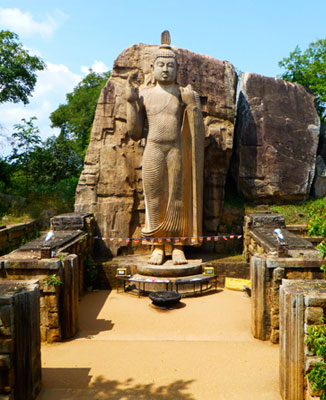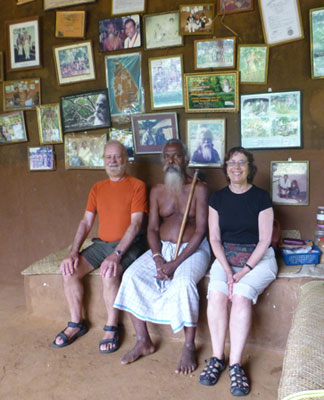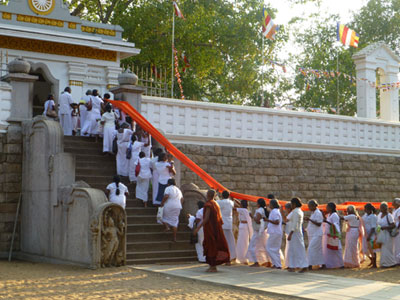Ceylon Express for Sri Lanka
This item appears on page 26 of the September 2015 issue.
In my search for a custom tour of the Indian Ocean island of Sri Lanka, I began by contacting tour companies, including ITN advertiser Ceylon Express International (Huntington Beach, CA; 800/423-9566, www.ceylonexpress.com), whose owner, Varini De Silva, was head and shoulders above her competitors in response time, advice and satisfying my travel requirements.
To see all the principal sites and also have downtime, it was apparent the trip needed to be 30 days, and even then we had to eliminate the far north and east.
My husband, Jerry, and I took the trip Feb. 10-March 12, 2014, and the cost of $5,815 per person, double occupancy, covered 31 hotel nights, a driver/guide for the entire trip, two jeep safaris and all entry fees. Airfare on Qatar Airways (a very long, 24-hour trip one way) was $1,115 per person. Our 30-day visas cost $30 apiece at the Sri Lankan embassy.
Our hotels ranged from basic to high-end. We particularly liked Lake Lodge (20 Alvis Terrace, Colombo; http://taruvillas.com/lake_lodge.php), one of the basic hotels. It was central yet quiet.
Of the high-end hotels, our favorites were the Grand Hotel (Nuwara Eliya City Center, Nuwara Eliya; www.grand-hotel-nuwara-eliya-sri-lanka.en.ww.lk), Fort Printers (39 Pedlar St., Galle Fort, Galle; www.thefortprinters.com) and AVANI Bentota Resort & Spa (Bentota; www.avanihotels.com/bentota).
One of the little touches that impressed me about Varini — the original plan was to visit Sri Lanka in early February, but she knew of a festival in Colombo on Feb. 14 and asked if we could delay our trip to include it. The nearly 3-hour spectacular featured 100 elephants plus drummers, pipers, dancers, whip throwers, fire twirlers and more.
Our driver/guide, Rohan Medis, was pleasant and resourceful and took excellent care of us, making suggestions that improved our itinerary.
After three pleasant days in Colombo, we headed north to Anuradhapura and Mihintale to see the oldest temples and ruins. In the third century BC, this was where Buddhism was first introduced to Sri Lanka.
Moving forward in historical time, we drove south to Habarana, with a stop in Aukana to see the magnificent, 5th-century, 39-foot, rock-cut Buddha statue. The details on the folds of Buddha’s robe are delicate and flowing, and the face is beautiful.
Habarana was our headquarters for Polonnaruwa, Kaudulla National Park and Sigiriya.
Polonnaruwa was the capital of Sri Lanka in the 11th and12th centuries. The complex holds the royal palace, royal administrative buildings, shrines and the remains of trade stalls. The structures are very impressive, but they have not weathered well and look older than the ones in Anuradhapura, even though they are much more recent.
Nearby, Sigiriya is a 5th-century rock fortress that juts up out of the landscape. King Kasyapa lived there with his entourage and his 500 wives. The lower, summer palace had magnificent water gardens. The upper palace, 660 feet high, is quite a climb. About halfway up, we were rewarded with the sight of 18 remaining, exquisite frescoes of celestial maidens.
We continued south, stopping in Dambulla to see the rock cave temple, which has 48 statues of Buddha plus marvelous paintings of many more Buddhas on the wall. These are incredibly beautiful, especially since the natural folds of the rock were used to give the illusion of cloth and movement.
Kandy was the last Sri Lankan kingdom, lasting from 1594 to 1815, when the king abdicated to Britain. Kandy is built in a valley surrounded by mountains and is chock-full of traffic, but it does have a lovely lake in the center and the magnificent Temple of the Tooth, which contains multiple temples and the old royal library. Other important temples surround Kandy.
Not all of our time was spent on historical sites. We also went on two safaris, the first near Habarana in Kaudulia National Park, where we saw elephants. The second was in Yala National Park, where we were lucky enough to see a leopard meandering very close to our vehicle.
We stopped at the Elephant Transit Home in Udawalawe National Park, where orphaned elephants are returned to the wild at about age 8. We watched one of the five daily feedings. Such fun!
We also went on a half-day hike in Horton Plains, visited a tea museum and a tea plantation, spent a morning at a village of indigenous Vedda people, learning about their culture, and relaxed at a beach for five days.
What impressed me most about Sri Lanka, aside from the historical, religious and natural wonders, were the people. We felt truly welcomed. The merchants we met were helpful but not aggressive. Tuk-tuk drivers asked if we’d like a ride, and when we said “No,” they responded with, “Have a nice day.” When we did want their services, it was easy to agree on a price, usually about $2.
The food was inexpensive, usually $7-$10 for a meal. On the road, most of our meals were buffet-style, with both spicy and bland choices. We often ate at our hotels, since many were isolated, but the food was excellent and the meal price usually under $10.
NILI OLAY
New York, NY



